





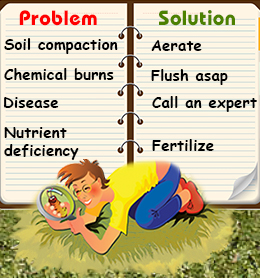 Did you know...... that yellow spots don't just look bad, they also could be indicators of a fungal disease, pest infestation or poor soil quality.With the temperature declining and mild weather approaching, you might be looking forward to spend some time in the garden. But, for all you know the pretty sight is ruined by ugly, damaged patches of yellow grass.
Did you know...... that yellow spots don't just look bad, they also could be indicators of a fungal disease, pest infestation or poor soil quality.With the temperature declining and mild weather approaching, you might be looking forward to spend some time in the garden. But, for all you know the pretty sight is ruined by ugly, damaged patches of yellow grass.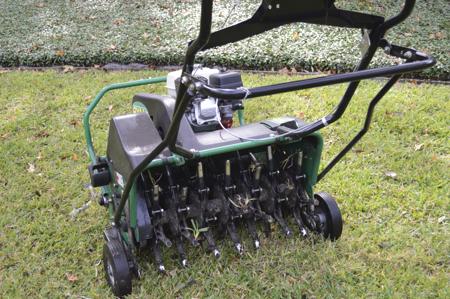 Grass damaged due to excess traffic can be fixed by aerating it. You can rent a core aerator from a near-by store. For smaller lawns, the soil can be aerated with a fork - dig in the fork, about an inch in the soil then pull it out. Water the lawn a day before so that it is moist and easy to pierce. Follow the aeration with adding grass seeds, fertilizer and finish-off with a layer of loam. In case the lawn is too damaged and you need a quick-fix, sods are a great option too.
Grass damaged due to excess traffic can be fixed by aerating it. You can rent a core aerator from a near-by store. For smaller lawns, the soil can be aerated with a fork - dig in the fork, about an inch in the soil then pull it out. Water the lawn a day before so that it is moist and easy to pierce. Follow the aeration with adding grass seeds, fertilizer and finish-off with a layer of loam. In case the lawn is too damaged and you need a quick-fix, sods are a great option too.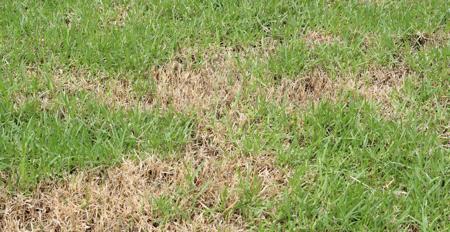 Chemical burns can be a result of using too much fertilizer. You might find discolored or yellowing grass in stripes mimicking the pattern in which you spread the fertilizer after a day or two of fertilizing. Another cause of a chemical burn is accidental spilling of a chemical like fertilizer, herbicide or even gasoline.Solution: Flush it Out
Chemical burns can be a result of using too much fertilizer. You might find discolored or yellowing grass in stripes mimicking the pattern in which you spread the fertilizer after a day or two of fertilizing. Another cause of a chemical burn is accidental spilling of a chemical like fertilizer, herbicide or even gasoline.Solution: Flush it Out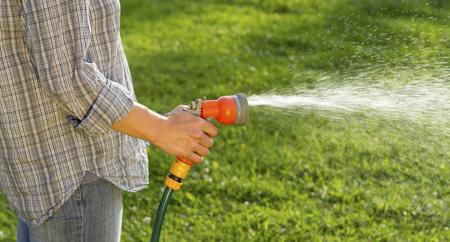 The best way to minimize damage is of course by prevention - avoid filling up containers or gardening equipment on the grass. But if you have already spilled or over-fertilized, water the patch immediately to drain out the chemical and minimize damage. You might have to water the area everyday for a week, and put in compost and rock dust to compensate for lost minerals. If the grass has already died, then the best thing would be to put a sod over the damaged portion or reseed it in the next season.Problem: You've Mowed Too MuchMowing the grass cuts the leaves - the food factory of your lawn and results in shallow, immature root system. The cut grass also grows much faster, further driving up the energy need of the plant and putting additional stress on it. Visibly, 'bare spots' or yellow spots might also appear on your lawn as the new growth is more vulnerable to the elements, pests and weeds.Solution: Cut Often and Cut a Small Amount
The best way to minimize damage is of course by prevention - avoid filling up containers or gardening equipment on the grass. But if you have already spilled or over-fertilized, water the patch immediately to drain out the chemical and minimize damage. You might have to water the area everyday for a week, and put in compost and rock dust to compensate for lost minerals. If the grass has already died, then the best thing would be to put a sod over the damaged portion or reseed it in the next season.Problem: You've Mowed Too MuchMowing the grass cuts the leaves - the food factory of your lawn and results in shallow, immature root system. The cut grass also grows much faster, further driving up the energy need of the plant and putting additional stress on it. Visibly, 'bare spots' or yellow spots might also appear on your lawn as the new growth is more vulnerable to the elements, pests and weeds.Solution: Cut Often and Cut a Small Amount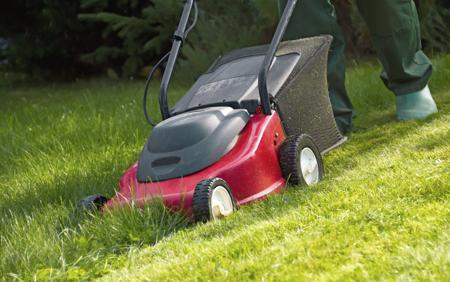 Every grass will have its own optimal height - for example, St. Augustine should be between 3-4 inches tall. It is best to stick to the upper limit, especially during summer. Also, note that you should not cut more than 1/3rd of the leaf tissue in one go. Use a different direction every time you mow, to reduce compaction and make sure that the blades of your mower are sharp.Problem: Pet Urine
Every grass will have its own optimal height - for example, St. Augustine should be between 3-4 inches tall. It is best to stick to the upper limit, especially during summer. Also, note that you should not cut more than 1/3rd of the leaf tissue in one go. Use a different direction every time you mow, to reduce compaction and make sure that the blades of your mower are sharp.Problem: Pet Urine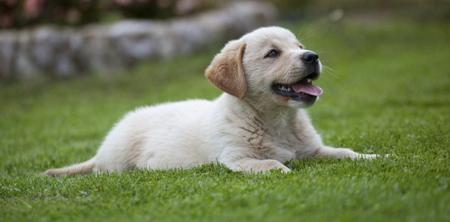 Pets, especially dogs, love to go on lawns. Unfortunately, the nitrogen in their urine might be high enough to kill the grass and result in yellow spots.Solution: Train the DogTeach your canine to not pee on the lawn. Train the dog to go on a rocky or muddy patch. Just in case the pet urinates on your lawn, flush the place with water. Also, make sure the dog drinks plenty of water and reduce the amount of protein in their diet. This will reduce the amount of nitrogen in their urine. You can also use products designed to alter the dog's urine.Problem: Diseases and Pests
Pets, especially dogs, love to go on lawns. Unfortunately, the nitrogen in their urine might be high enough to kill the grass and result in yellow spots.Solution: Train the DogTeach your canine to not pee on the lawn. Train the dog to go on a rocky or muddy patch. Just in case the pet urinates on your lawn, flush the place with water. Also, make sure the dog drinks plenty of water and reduce the amount of protein in their diet. This will reduce the amount of nitrogen in their urine. You can also use products designed to alter the dog's urine.Problem: Diseases and Pests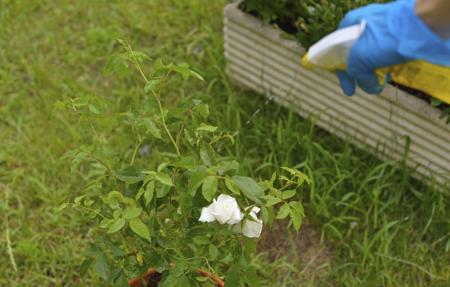 A large number of varieties of bugs or fungal infections can cause your lawn to develop spots of discoloration. These might have a distinct pattern, with some turning the edges yellow or causing brown spots to appear on the blade of the grass.Solution: Contact an ExpertAlthough many of the diseases are recognizable, it is best you contact the USDA's Cooperative Extension System Office or a lawn-care expert before you attempt to treat the disease or infestation.Problem: Not enough nutrientsThe soil in your garden might not have the right balance of nutrients for the grass to thrive, causing nutrient deficiencies and poor growth. Nitrogen is one of the most important macro-nutrient, be it for a potted plant or your lawn grass. It is needed for growth and chlorophyll production - which gives the plant its green color. A nitrogen-deficient plant is characterized by yellowing leaves - first the old leaves turn yellow followed by younger leaves. Older leaves may also die and the grass takes on a yellowish tinge overall. Magnesium, Manganese, Sulfur and Iron are other nutrients which can cause your grass to turn yellow or even make it crinkle and die.Solution: Fertilize
A large number of varieties of bugs or fungal infections can cause your lawn to develop spots of discoloration. These might have a distinct pattern, with some turning the edges yellow or causing brown spots to appear on the blade of the grass.Solution: Contact an ExpertAlthough many of the diseases are recognizable, it is best you contact the USDA's Cooperative Extension System Office or a lawn-care expert before you attempt to treat the disease or infestation.Problem: Not enough nutrientsThe soil in your garden might not have the right balance of nutrients for the grass to thrive, causing nutrient deficiencies and poor growth. Nitrogen is one of the most important macro-nutrient, be it for a potted plant or your lawn grass. It is needed for growth and chlorophyll production - which gives the plant its green color. A nitrogen-deficient plant is characterized by yellowing leaves - first the old leaves turn yellow followed by younger leaves. Older leaves may also die and the grass takes on a yellowish tinge overall. Magnesium, Manganese, Sulfur and Iron are other nutrients which can cause your grass to turn yellow or even make it crinkle and die.Solution: Fertilize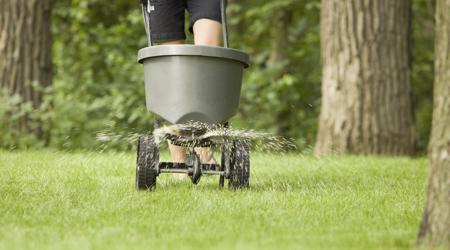 Give the plant a mineral boost with a fertilizer. Look for the ones with ammonia, nitrate or urea in their name for nitrogen, and 'added micro-nutrients' for iron, sulfur, manganese or magnesium. Manures are excellent fertilizers too, both cattle or poultry manure may be used. Another option is to put blood meal, feather meal, bone meal, alfalfa or soybean in your compost.A lawn can also get damaged by extreme heat and drought conditions. In such a case, the best thing to do would be to wait till fall, to reseed the lawn. Make it an annual custom, reseeding in fall or early spring will make it thick and minimize weeds. Also deep-watering the entire garden before 9 AM is a practice that will ensure not just a healthy, green lawn but will also benefit other plants. Another thing to consider would be using a hardier variety of grass, suitable for your climatic conditions. For example, Kentucky bluegrass will do good in cold climate, but might not be suitable for a place with frequent droughts.
Give the plant a mineral boost with a fertilizer. Look for the ones with ammonia, nitrate or urea in their name for nitrogen, and 'added micro-nutrients' for iron, sulfur, manganese or magnesium. Manures are excellent fertilizers too, both cattle or poultry manure may be used. Another option is to put blood meal, feather meal, bone meal, alfalfa or soybean in your compost.A lawn can also get damaged by extreme heat and drought conditions. In such a case, the best thing to do would be to wait till fall, to reseed the lawn. Make it an annual custom, reseeding in fall or early spring will make it thick and minimize weeds. Also deep-watering the entire garden before 9 AM is a practice that will ensure not just a healthy, green lawn but will also benefit other plants. Another thing to consider would be using a hardier variety of grass, suitable for your climatic conditions. For example, Kentucky bluegrass will do good in cold climate, but might not be suitable for a place with frequent droughts.
Copyright © www.100flowers.win Botanic Garden All Rights Reserved